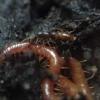This reply is a day late, I was trying to feed the colonies in experiment 04 for the first time but the supplier decided to use different size glass tubes this time so I had to grind the feeding trays down to fit inside. After I tried so hard to measure out 14mg of honey I had to wipe it all off and start over..!
CoolColJ,
That’s an interesting nest you have there. That is a very dry nest. Is that a salt solution on the left? Diluting water with sodium chloride or magnesium nitrate will reduce relative humidity, thereby reducing the dew point that will prevent condensation. Well actually reduce evaporate rate but the result is the same. Does the manufacturer specify what everything is made of? I can understand the 55-78% RH gradient given the fact that one end is not 99% like you would find in a standard test tube setup. It would make me happy if you could take a picture with the black top taken off. Do you just saturate the white solution and it works for watering the nest? How much water do you put in to the reservoir? Is the shiny white substrate littering the bottom and walls of the gypsum salt or sand?
Currently it is winter in Australia – low humidity and low temperatures [as a person living in a place that reaches freezing temperatures regularly in the winter it seems odd to say this]. There is very little ventilation, but it is still more than what a cotton ball would provide. Is it wrong for me to come to the conclusion that humidity inside small enclosed areas depend on the amount of actual moisture available and the RH of the immediate surrounding area? In other words it seems that the design for that formicarium does not even begin to require a fraction of the volume of water a standard test tube setup would need. Then it distributes and slows down the evaporation rate sideways to make for a dry nest. If you were to completely saturate the sand I am sure you would get 99% RH readings across the board?
If your RH is 60% and temperature is 70 degrees F (21.1 C), dew point is 55 F (12.7 C). Of course there is no condensation.
I can’t do the barbeque skewer thing you did because my formicarium has alternating openings per floor. Had to cut the pipette housing to make it fit. A larger formicarium or simpler design would certainly make testing easier. I need to change a bunch of things with this one. See picture:

AntsAreUs,
Good to have you on board. So you hypothesize that captive conditions for that particular species would allow for a higher growth ceiling due to the benefits of a more varied and available diet? That’s interesting and certainly possible. My colonies might need a bit more time to catch up to your colonies but maybe collaboration in the future is possible? I am standardizing my experimenting methods so it would be easy for anyone to contribute.
In regards to exotic species pride and jealousy, I couldn’t care less. This is my opinion. I mean, I’m probably just going to end up with 30 Tetramorium Immigrans colonies and as many other species as I can get my hands on, which probably won’t be very many. I think ants are interesting enough as they are and getting a deeper look into one species rather than knowing a little about many colonies is more attractive to me. I can definitely see the appeal of having experience with many different species though! Different strokes for different people.
For example, the official Tetramorium Immigrans colony care sheet on the forums now has incomplete information at best. People are going to read that and follow the information on there to a T. Less than 1 month of proper testing already disrupts accepted standards. The recommended temperature is off by more than 10 degrees and humidity is off by 50%. Growth rate does not display a range so the numbers are inaccurate. A lot of figures on the forums here are anecdotal so I guess I’m doing my part to remedy the lack of solid facts, so I have a purpose of doing such a specialized study.
Hello dermy.
That colony is crazy right? I haven’t seen his recent videos but I’d think it’s easily over 100,000 ants. But to be honest that tank is not large enough to house a million ants unless he moved them over to a larger tank recently? His aquarium is approx. 48” x 24” x 16”, not to mention a little less than half of it is water. Soil is maybe 7” deep? So that gives us about 4000 cubic inches for living space. If we assume 50 ants per cubic inch the max capacity of that tank is 200,000 ants. By the way, 50 ants in a cubic inch means frigging overpopulation. If his ants are very small, maybe 100 ants a cubic inch? That’s still only 400,000 max capacity. I should probably watch one of his videos because my figures are based off memory, but if anyone wants to double check feel free to do so. I don’t think that tank can hold a million ants.
Wild colonies and super colonies are definitely impressive, especially that one in Japan. I’m not going to try to even get to that figure. Just trying to see how far I can take this and give back some data to the ant keeping community while I’m at it.
I’m going to ask again for anyone reading this if they have recommendations for diet. I’m willing to test almost anything since I can standardize the diet for all the samples so that variable will stay constant. Right now it’s just honey and wingless fruit flies (Drosophila Melanogaster). All my mealworms have turned into beetles and the eggs still haven’t hatched - thinking of boiling and cutting up the beetles with a scapel so they’ll be able to get inside. Good idea?





























